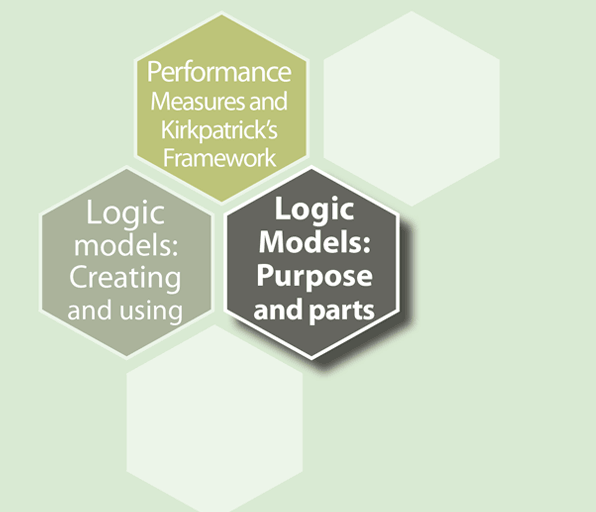Introduction
A sound and realistic logic model can guide us in developing and implementing program evaluations that produce relevant, evidence-based information about a program’s effectiveness.
Learning Objectives (what you can reasonably expect to learn in the next 15 minutes):
- Describe the main purposes of a logic model.
- Distinguish among four main components typically included in logic models.
To what extent are you now able to meet the above objectives? Please record your self-assessments. (0 is not at all and 5 is completely)
To get you warmed up … based on your prior knowledge and/or experience, match the terms (1. Inputs 2. Activities 3. Outputs 4. Outcomes) to an example of program evaluation components:
Terms: 1. Inputs 2. Activities 3. Outputs 4. Outcomes
Logic Models for Program Evaluation: Purpose and Parts
Purpose: A program logic model is a visual representation of how we anticipate that the resources invested in a program will lead to the results we intend to achieve.
Logic models illustrate our logical assumptions about how the resources invested in a program will be used to carry out activities and produce products or services that will contribute to achieving a chain of expected results (e.g., “If we deliver x then y will occur, which should then result in z”). These “if-then” assumptions, as depicted in a logic model, represent the basic components of a program’s theory of change – that it, our theory about how a program will effectively lead to a desired change.
By illustrating our expectations about how a program will be effective, logic models allow us to:
- Verify that our expectations for the program’s effectiveness are sound and realistic.
- Ensure that there is clarity and consensus among those who fund and deliver the program about the resources available to deliver the program, the key program activities and what they produce, and the program’s expected outcomes.
- Communicate information about our program to internal and external stakeholders in a reader-friendly, visual manner.
- Select relevant performance measures, aligned with our expectations of the program as depicted in the logic model.
- Interpret program data and their implications regarding the extent of program effectiveness.
Components: Logic models come in various formats: some contain more components than others and the labels used to describe the components vary, as does the direction in which the logical model is presented (e.g., left-to-right, top-down).
Keeping this flexibility in mind, logic models typically depict the relationships between the following program components in a logical or reasonable sequence:
- Inputs: The resources invested/available to deliver the program.
- Activities: The key activities/actions carried out, using the inputs.
- Outputs: The products and services that are delivered as a result of the program activities.
- Outcomes: The changes that are expected to occur over time, in the short-, medium-, and long-term, as a consequence of the program’s activities and outputs.
Outcomes are often grouped according to the order in which we expect the results of the outputs to occur.
-
- Immediate outcomes result directly from the delivery of outputs.
- Intermediate outcomes are the changes anticipated after immediate outcomes are achieved.
- Ultimate outcomes are the furthest reaching changes that can reasonably be attributed to the program after the immediate and intermediate outcomes have been achieved.
Logic Model Components
| Logic Model Components | Example 1: Simulation Lab Training Program | Example 2: Student Recruitment Diversity Program |
|---|---|---|
| Inputs Resources invested |
money, human resources, facilities, and equipment | money and human resources |
| Activities Actions carried out |
Revise and deliver training to students Develop and administer assessment tools |
Develop and implement student recruitment strategy for under-represented demographic groups |
| Outputs Products and services delivered |
Training delivered to the targeted students Assessments conducted |
Promotional materials and information sessions delivered to under-represented demographic groups |
| Outcomes Expected changes |
||
| Immediate Direct result of outputs |
Increase students’ engagement / knowledge / skills | Increase awareness of program among under-represented demographic groups |
| Intermediate Changes anticipated after achievement of immediate outcomes |
Improve quality of students’ work in applying what they have learned | Increase number of applicants from under-represented demographic groups |
| Ultimate Furthest reaching changes attributable to the program |
Enhance quality of patient care provided by students in clinical learning environment | Increase number of enrolled students from under-represented demographic groups |
Check for Understanding
Self-assessment
To what extent are you NOW able to meet the following objectives? (1 is not at all and 5 is completely)
To what extent WERE you able just before beginning this Cell to meet the following objectives? (1 is not at all and 5 is completely)

Thank you for completing this CORAL Cell. We are interested in improving this and other cells and would like to use your answers (anonymously of course) along with the following descriptive questions as part of our evaluation data.
Thanks again, and come back soon!
The CORAL Cell Team
Credits:
Author: Vanessa Anastasopoulos, McGill University
Series Editor: Marcel D’Eon, University of Saskatchewan
Reviewer/consultant: Derek Wilson, University of British Colombia
